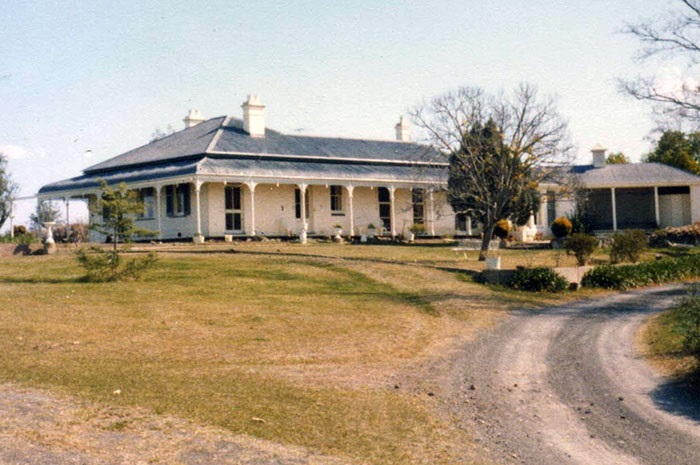History of Blairmount
The following text is from "Campbelltown's Streets and Suburbs - How and why they got their names" written by Jeff McGill, Verlie Fowler and Keith Richardson, 1995, published by Campbelltown and Airds Historical Society. Reproduced with kind permission of the authors.
Blairmount, unlike other local suburbs, doesn't have streets named after romantic poets, famous women, noble explorers or early pioneers. Its roadways have a much more four-legged and equine flavour - because they pay tribute to... horses.
Not that you'll find a Mr Ed Avenue or a Phar Lap Place anywhere.
Blairmount's streets actually recall great horse breeds, in recognition of a fine stud that stood on the hilly site earlier this century.
There is not a huge deal of information available on the history of the old Blairmount property(PDF, 218KB), but we do know the farm homestead was built in the late Victorian era. And the building still exists, standing on scenic protection land below St Gregory's College, with sweeping views of Campbelltown.

"Blairmount" historic home in 1979, Badgally Road, Campbelltown
Owners earlier this century were Clive and Victor Ducat, the latter serving as a local alderman. They were grandsons of a Scottish migrant, William Ducat (pronounced Duck-at).
But the Badgally Road property and homestead wasn't known as Blairmount in these early decades of the century. It was actually Belmont.
Leslie Rouse acquired the bulk of the property in 1923, but the Ducats held onto some land in the area occupied by the present suburb until 1929. In that year, the two brothers sold out to Charles McClelland of the adjacent Glenroy farm (see Claymore). Meanwhile Rouse developed his newly-acquired home as a horse stud, employing Clive ducat as his manager.
A little known fact is the role the Ducats played in ridding Campbelltown of one of its worst ever plagues - prickly pear. In the early part of the century, hundreds of good farm acres were being destroyed by the ugly pest, which had gone berserk across NSW and Queensland. Chopping it down and burning it only seemed to drive the frenzy of growth.
A big reason for its success was the fact it had no natural enemies. Yet the unlikely saviours were tiny insects from South America - Cactoblastis Cactorum - which lived on the cactus and were introduced in 1925. But many farmers scoffed at suggestions an insect could help and refused to consider it. In June 1926, the Campbelltown News reported Vic Ducat had taken up the challenge.
"Unfortunately for Mr V A Ducat, his farm off Badgally Road, contains no small amount of prickly pear", reported the press "and although he used many methods to diminish its growth, fresh segments of the destructive pest put in an appearance." So ignoring the ridicule and claims the insects were "useless", Ducat contacted the authorities.
Soon, the front page of the News was hailing his efforts as "a huge success at little cost". It reported: "It is not 18 months since Mr Ducat procured a small supply of Cochineal insects and placed them on a few plants in the thickly-infected pear area, and today the results are conspicuous. This patch is now dying, and the insects have traversed 60 to 100 yards in every direction." Before long, other local farmers were following his lead.
After Rouse's death in 1928, Frank Young, manager of the Commonwealth Wool Company, purchased the property, which at the time totalled 175 acres (70ha). By now, it was known as Blairmount. "Blair" is Scottish word meaning "cleared space".
Young increased the size of his holding by purchasing adjoining land and specialised in breeding prize-winning Clydesdale horses until his death in 1951. These heavy draught horse, originally bred near the River Clyde in Scotland, are today honoured by the modern suburb's main road -Clydesdale Drive.
Developed with housing in the 1980's, the nearby hills had been transformed into small a neighbourhood named after the Blairmount farm. Yet in its earliest years it was often misspelt as "Blairmont".
Blairmount Public School was opened in 1983, but had been operating in nearby Claymore as Badgally School since 1978.
The potential for further urban expansion of the suburb is limited, as it is hemmed in by the protected Scenic Hills zone to the west and south, by the Hume Highway to the east, and by Claymore to the north.
In August 1980, Campbelltown Council approved the notion of naming streets in Blairmount after famous horse breeds.
Those now noted include the British breeds, the Shetland pony and the Exmoor. Nearby Jaf Place pay tribute to a Persian breed, while the main loop road, Appaloosa Circuit, recalls the renowned American horse.
A special mention should go to Waler Place, named after Australia's own equine. It was mainly bred in New South Wales (hence its name) as a hardy army mount for British forces serving in India during the 19th Century.
This same breed carried the famous Australian Light Horse battalions across the deserts of the Middle East in World War One, winning wide respect for their endurance.
In case the suburb does eventually expand south into the hollow beside the Hume Highway, Council has already approved street names.
These are Calabrese Street (Italian), Barn Place (Algerian), Pencheron Street (French), and Dales Close (English).
Thomas Burke Reserve, off Badgally Road, is named after the man who originally farmed the 100-acre (40ha) grant on the site.